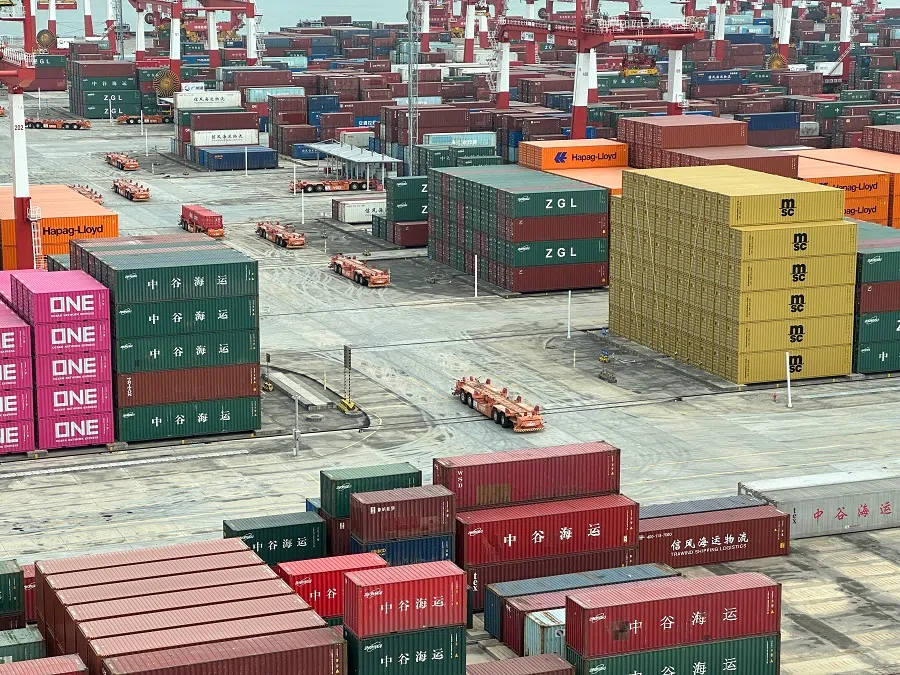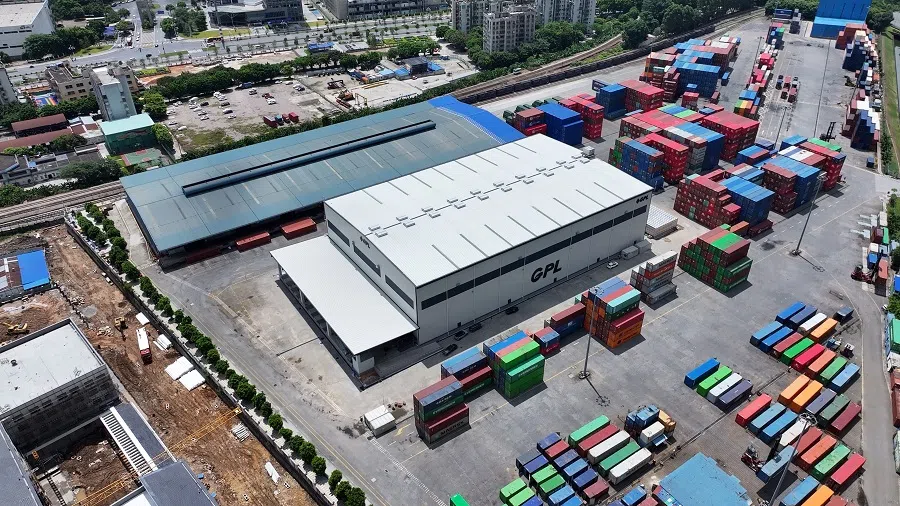Nansha’s automated port challenges Hong Kong in the Greater Bay Area
Nansha Port is a relatively new facility, but it is doing enough to find its own feet in the Greater Bay Area, even becoming a credible challenge to an established port like Hong Kong. Lianhe Zaobao’s correspondent Daryl Lim visits Nansha Port to find out more.

At Nansha Port Phase IV in Guangzhou, colourful containers are being moved like huge blocks. Despite the frequent activities of harbour cranes and trucks, the entire operation here is strangely quiet, with hardly any port worker in sight.
Yu Yinhui, an engineer in the Engineering and Technology Department at Nansha Port Phase IV, told Lianhe Zaobao that the terminal is fully automated, the first in the Greater Bay Area (GBA).
70% less workers than traditional port terminals
Harbour cranes at the terminal load and unload containers in an orderly fashion using 5G communications and the Beidou navigation system. After unloading, the containers are moved by intelligent guided vehicles (IGVs) and rail-mounted gantry cranes to container yards or directly loaded onto container trucks. The entire process needs no human intervention and can operate round the clock.
Yu said there are about 350 employees in Phase IV, which is 70% less than traditional port terminals. “Traditional roles like dockworkers and drivers are now obsolete, with correspondingly more technical positions in automated equipment maintenance, systems management and data analysis.”
“The entire automated system operates based on scanned and learned data, and is more ‘obedient’, accurate and reliable than human workers.” — Yu Yinhui, an engineer in the Engineering and Technology Department, Nansha Port Phase IV
However, the reduction in manual operations at the terminal does not necessarily mean that its overall efficiency has greatly improved. Yu candidly says that when the automated terminal commenced operations two years ago, its efficiency was actually slightly below that of manual operations. However, with continuous optimisation of technology, the terminal’s efficiency is now equivalent to and is expected to surpass that of manual operations in future.
He said, “Our technical team continues to innovate and optimise the operations based on data. As the fully automated terminal has been operational for only two years, there is much room to improve efficiency, and great potential for future development.”

Besides improving efficiency, automated operations can also effectively prevent irregularities in manual operations, thus reducing potentially dangerous accidents and delays. Yu said, “The entire automated system operates based on scanned and learned data, and is more ‘obedient’, accurate and reliable than human workers.”
Built in 2004, Nansha Port is located at the mouth of the Pearl River, which is the only channel from Guangzhou to the ocean. As a relatively new port in its early days, Nansha Port has clear disadvantages compared with neighbouring ports in terms of reputation, market opportunities, use of IT and economic structure optimisation.
However, with structural changes to the industry at the GBA and the continuous upgrading of transportation, terminals and warehousing, Nansha Port’s growth momentum is becoming increasingly obvious.
Surpassed Port of Hong Kong in throughput
Many in the industry believe that an important reason for the rapid development of Nansha Port is that it remained in operation during the pandemic, attracting a large number of freighters bound for the Port of Hong Kong and Yantian Port in Shenzhen. Due to the pandemic outbreak at these two ports, freighters were redirected to Nansha Port, consequently elevating its importance in the global shipping network.
In 2023, Nansha Port’s throughput reached 19.38 million TEUs (twenty-foot equivalent units), a year-on-year increase of 5.4%, making it the ninth largest port in the world. In the first quarter of 2024, its throughput was 4.78 million TEUs, up 10.56% quarter-on-quarter.
While Nansha Port’s throughput continues to increase, the once exceptional Port of Hong Kong is on the decline. In 2022, Nansha Port surpassed the Port of Hong Kong in throughput. In its seventh consecutive year of decline, the latter’s throughput decreased by 14.1% year-on-year in 2023. According to Alphaliner, an international shipping industry research organisation, the Port of Hong Kong, which had ranked first in throughput for 11 consecutive years globally, has also dropped out of the top ten in 2023 for the first time.
Some analysts have pointed out that the decline in throughput of the Port of Hong Kong is closely related to the emergence of Nansha Port.
... the Port of Hong Kong has suffered from an uneven playing field, where some competitors and shipping lines receive government subsidies in various forms that undermine its competitiveness. — a spokesperson for Hongkong International Terminals Limited, Hutchison Port Holdings Trust

In response to questions from Lianhe Zaobao, a spokesperson for Hongkong International Terminals Limited under Hutchison Port Holdings Trust said the Port of Hong Kong’s throughput decline can be attributed to geopolitical factors in recent years and the mainland Chinese enterprises relocating their production to Southeast Asia.
The spokesperson added that, compared with neighbouring ports in the GBA and other parts of Asia, the Port of Hong Kong has suffered from an uneven playing field, where some competitors and shipping lines receive government subsidies in various forms that undermine its competitiveness.
In an interview, Liu Rui, deputy chief of Guangzhou Port Company Limited, believed that there is no competition between Nansha Port and the Port of Hong Kong. He said Nansha Port’s advantage lies in its geographical location nearer to the Pearl River hinterland, especially the western part of the Pearl River Delta, where goods are in relative abundance.
Port of Hong Kong’s new positioning in the GBA
In the past ten years, with the rapid economic development of the Pearl River Delta, labour costs have gone up and land resource is increasingly in demand in the relatively more developed eastern part of the delta. With the support of tax incentives and financial subsidies, many manufacturers are beginning to relocate to the inland areas in the western part of the delta.
Liu felt the Port of Hong Kong’s customers are mainly from developed countries and cities in Europe and the US. With this advantage, the Port of Hong Kong can leverage the abundance of goods in the hinterland of the western part of the Pearl River delta to increase the conveyance of containers from Nansha Port by barges, to expand its port business to and from Europe and the US. He said: “Being in the GBA, both ports should jointly enhance the overall competitiveness of the region.”
“The Port of Hong Kong cannot continue its previous mode of operation and must discover its new positioning in the GBA to give full play to its unique advantages and complement other ports.” — Ricky Tsang Chi Ming, Vice-Chairman, Chinese General Chamber of Commerce, Hong Kong
Ricky Tsang Chi Ming, vice-chairman of the Chinese General Chamber of Commerce, Hong Kong, and chairman and CEO of the Goldlion Group, also agreed that the relationship between Nansha Port and other ports should be viewed from the perspective of the GBA’s overall development. He said, “The Port of Hong Kong cannot continue its previous mode of operation and must discover its new positioning in the GBA to give full play to its unique advantages and complement other ports.”
The Hongkong International Terminals Limited spokesperson said the company, as part of the GBA’s integrated development, is actively increasing cargo traffic from China’s hinterland by railway connection. For example, the recently launched Chongqing-Shenzhen-Hong Kong Scheduled Train completed its inaugural shipment from Chongqing to Hong Kong in August 2024.
“Despite facing great challenges, the Port of Hong Kong retains its competitive advantage and is in a strategic position of adaptation and development amid the changes in the GBA in the next five to ten years,” the spokesperson said.
Port of Huangpu: creating new services
On the northern shore of the Pearl River Delta in Guangzhou, a brand-new warehouse stands in the historic Port of Huangpu, in stark contrast with its older surroundings.

This fully automated warehouse, featuring Automated Storage and Retrieval Systems (ASRS), was tested and commenced operations on 10 October 2024. Known also as a high-bay warehouse, the 23.5-metre-high building occupies about 6,000 square metres, equivalent to a soccer field, with 16,000 cargo bays that store goods of over 16,000 tons. Its space utilisation is about 200% higher than that of ordinary warehouses with the same floor area.
Constructed and operated by Guangzhou PSA Logistics Co., Ltd. (GPL) — a joint venture by the Port of Singapore Authority (PSA) and the Guangzhou Port Group — it is currently the largest single automated warehouse with ASRS for Category C1 goods in Guangzhou.
Category C1 refers to goods with higher fire rating, including mainly liquids with flash point at or above 60°C, such as animal oil, lubricating oil and asphalt. These items are highly flammable, and the warehouses for storage must have higher fire safety requirements.
When interviewed by Lianhe Zaobao, Goh Yu Tian, assistant to the general manager of GPL, said warehouses for Category C1 goods are mainly used to store liquid chemicals for production. Unlike ordinary warehouses, investment costs to build such warehouses are high and the rate of return is relatively low. As a result, they are rare in the market.

She said, “The risks of investing in such warehouses are generally jointly borne by large state-owned enterprises and multinationals. GPL has the rights to long-term land use in the Huangpu District and, by building and operating this warehouse, targets this vacuum in the industry. GPL considers this warehouse with ASRS a long-term investment”.
Goh noted that the impact of Covid-19 on global supply chains has led many manufacturers to recognise the increased risks of just-in-time production, prompting a shift towards a “just-in-case” strategy. “This change in strategy has prompted manufacturers to improve production flexibility, modify inventory management and enhance supply chain resilience. GPL’s warehouse with ASRS and integrated logistics services will provide better support for the future transformation of production strategy in supply chains,” she added.
This article was first published in Lianhe Zaobao as “南沙港崛起重塑大湾区港口竞争”.




![[Big read] Prayers and packed bags: How China’s youth are navigating a jobless future](https://cassette.sphdigital.com.sg/image/thinkchina/16c6d4d5346edf02a0455054f2f7c9bf5e238af6a1cc83d5c052e875fe301fc7)
